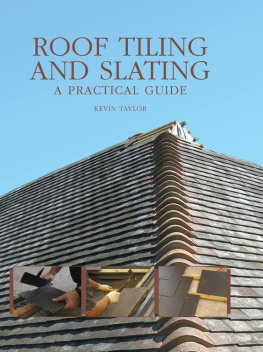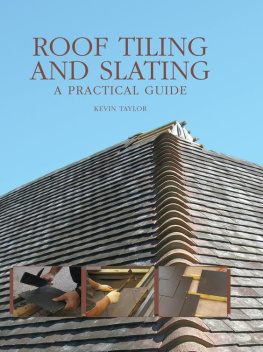First published in 2008 by
The Crowood Press Ltd,
Ramsbury, Marlborough,
Wiltshire, SN8 2HR
www.crowood.com
Revised edition 2013
This e-book edition first published in 2013
Kevin Taylor 2008 and 2013
All rights reserved. This e-book is copyright material and must not be copied, reproduced, transferred, distributed, leased, licensed or publicly performed or used in any way except as specifically permitted in writing by the publishers, as allowed under the terms and conditions under which it was purchased or as strictly permitted by applicable copyright law. Any unauthorised distribution or use of this text may be a direct infringement of the authors and publishers rights, and those responsible may be liable in law accordingly.
ISBN 978 1 84797 471 6
Dedication
This e-book is dedicated to all the great people in the roofing industry whom I have met over the years, but especially to my father Alan, sadly no longer with us.
Disclaimer
The author and publisher do not accept responsibility, in any manner whatsoever, for any error, or omission, nor any loss, damage, injury, adverse outcome or liability of any kind incurred as a result of the use of any of the information contained in this e-book, or reliance upon it. Readers are advised to seek specific professional advice relating to their particular house, dwelling, project and circumstances before embarking on any roofing, slating, tiling or building work of any kind.
I left school not knowing what I wanted to do for a living and so I decided to work for my fathers roofing company, for what I thought would be a few weeks until I found what I considered to be a proper job. Twenty-five years on and counting I am still in the roofing industry, despite several half-hearted attempts to leave it; it is, as they say, in the blood.
I hope that, as well as providing actual guidance on slating and tiling, this book will help in some way to encourage more people into what is still a cracking little trade; yes, it is hard work and you have the weather in the winter to contend with, but the freedom , the variety, the sense of pride on seeing the finished roof (something which lasts for years as you drive by places with which you have been involved), the banter on site, and the useful money you can now earn more than make up for the drawbacks.
It is true to say that roofers have not always enjoyed the best of reputations, but I have to say that, in my experience, most of the cowboy roofer stories involve people who are not really roofers at all. If more homeowners went to reputable firms rather than the unmarked van and mobile phone-only brigade then they would see that most do a good job at a fair price.
Roofing in general is full of people who are knowledgeable , skilful, passionate, cynical, funny, opinionated , resourceful and argumentative, but rarely dull. Many of them depending on their age, regional differences or personal grudges may read this book and no doubt disagree with some of it, but I have not tried to write a technically perfect manual that covers every eventuality. Instead, I have tried to write a book that covers commonly used methods, which are simple to understand and to follow.
Most of the photographs here were taken in a workshop situation on training rigs rather than on site. This allowed me to set up the exact situations I wanted, so I would like to thank the staff at Sandtoft Training and Assessment Centre (STAC) in Doncaster for allowing me to use their facilities.
Slating and tiling embraces a vast area of materials and situations, from re-tiling a front door porch to the restoration of a cathedral and everything in between. To cover all of these crafts and techniques and to make the text appropriate for the many types of person who potentially make up its readership could take many volumes to complete. Thus to cover the basics has proved quite difficult to do within one book of manageable size, but you will find that most of the common skills required in roof slating and tiling are covered in .
This book is aimed at serious DIYers, self-builders, students, improvers and those new to the trade, but it may also prove useful for more experienced roofers. It covers the tools, techniques and tips needed to install common materials, interlocking and plain tiles, natural and artificial slates on small to medium-sized projects with standard roof shapes and details. The book provides easy-to-follow instructions and techniques, tips on what to do (and what to avoid) and, above all, guidance on good practice. Its purpose is to help the reader to achieve a good quality roof, which will be durable, looks professional and, above all, keeps the water out.
While I have tried to ensure that the methods are in line with all the current British Standards (BS) and Health and Safety requirements, the book is not meant to be a substitute for them. Had I done so, it would have turned into a very long, vague, highly technical and possibly very dull piece of work, full of ifs, buts and maybes. Professional roofers and those who are intending to work on commercial projects should refer to the following publications as a minimum:
BS 5534: Code of practice for slating and tiling (including shingles)
BS 8000, Workmanship on building sites Part 6: Code of practice for slating and tiling of roofs and claddings (under revision at the time of writing) Health and Safety in Roof Work Health and Safety Guidance 33 (HSG33)
The first two are produced by the British Standards Institute and the third by the Health and Safety Executive. If you are intending to do your own lead work in a commercial environment I would also recommend a fourth publication the Lead Sheet Manual produced by the Lead Sheet Association (LSA). I have provided details on how to get all these publications in the contacts list at the back of the book.
THE FUNCTION AND PURPOSE OF SLATING AND TILING
The main function of slating and tiling is, of course, to keep the building watertight, to give it a good hat if you like. But slating and tiling are about much more than that, they are highly visual parts of a building, which add to the character of our townscapes in every aspect, from domestic dwellings to buildings of high historical importance.
One side effect of reading this book, I hope, is that you will feel compelled to look up at roofs and to comment on them in your daily life and wherever you go. Those of us in roofing will recognize this affliction (and so, I suspect, would our partners). If you travel about this country extensively you start to notice the character that roofing materials add to places. For example, the clay pantile roofs in areas such as Norfolk and Lincolnshire, the stone slates in the Yorkshire Dales, the different types of natural slate found in Wales, Scotland and the South-West, and the clay plain tiles that give so much character to many of our older domestic properties. Sometimes these materials are deemed to be so important to a building that they are relaid wherever possible, a process that I and other supporters of our heritage just love to see.
While much of what we do has not changed perhaps for hundreds of years, there is another side to roof slating and tiling and that is the new materials and techniques that have emerged and continue to do so. Concrete interlocking tiles and artificial slates have provided a cost-effective range available in a variety of finishes and colours for the new build and refurbishment market, we have modern roof windows which are relatively easy to install, dry-fix systems that replace sand/cement mortar with plastic alternatives, and high-tech roofing felts (underlay) that can breathe to help to combat condensation. These new materials are also shaping our townscapes and have added enormously to the pallet of roofing materials that can now be offered by the roofing industry.

















